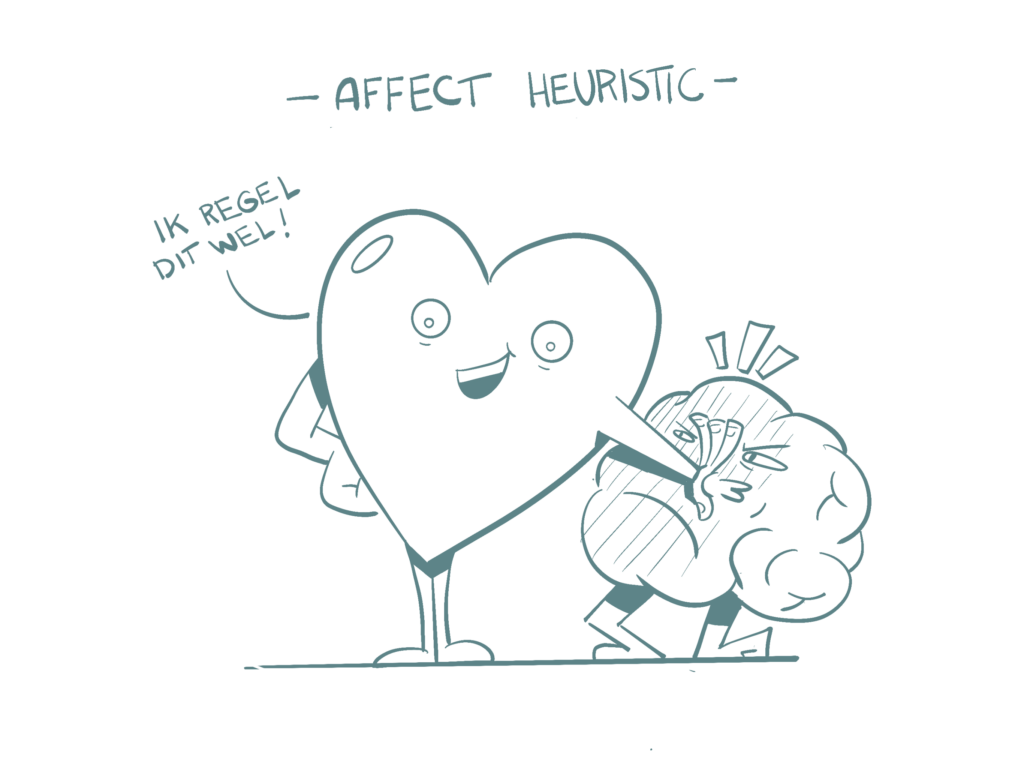
Last updated December 19, 2024
Introduction
Have you ever looked back on a decision and wondered why you thought it was a good choice at the time? It is likely that the affect heuristic played a role. This cognitive bias can influence both major and minor judgments and decisions. As an entrepreneur, it is crucial to be aware of the risks as well as the opportunities involved. By understanding how the affect heuristic works, you can make better, more informed decisions while reaping the benefits this bias can provide.
What is the affect heuristic?
The affect heuristic describes our tendency to make decisions purely on emotions, rather than based on objective data (Slovic, Finucane, Peters & MacGregor, 2000).
When we look at something or think about something, emotions always come into play. For example, we do not just see a car, we see a beautiful car, an ugly car or a fast car (Zajonc, 1980). The affect heuristic can lead to an underestimation of the dangers and an overestimation of the positive effects when associated with positive emotions and an overestimation of the dangers and an underestimation of the positive effects when associated with negative emotions (Cherry, 2020).
The affect heuristic comes into play especially when time constraints come into play or you're already running out of energy. As a result, we sometimes draw (wrong) conclusions faster than we should and can feel that there are fewer options than there actually are.
How does the affect heuristic arise?
According to dual process theory, we have two cognitive systems for making decisions: one that operates on autopilot and involves emotions (system 1) and one that requires effort and logical thought (system 2) (Finucane, Alhakami, Slovic & Johnson, 2000). Both systems have advantages and disadvantages. System 1 allows us to intuitively make quick decisions when needed, such as when you need to come to someone's aid or brake for sudden stopped traffic. But there are also major disadvantages to making quick decisions based on emotions.

Examples in practice
Fear mongering:
- Example: Politicians spread fear about certain problems that are very big.
- Effect: Voters get scared and choose based on emotions without properly examining whether a vote for this party is really in their best interest.
Purchase office supplies:
- Example: A business owner chooses to buy a particular brand of office supplies because he has fond memories of using that brand in the past, even when cheaper or better options are available.
- Effect: The decision is driven by positive feelings and past experiences, without a thorough comparison of alternatives.
Recruitment and Selection:
- Example: During a job interview, a manager decides to hire a candidate because he felt immediately comfortable with that person, despite the fact that another candidate might be better qualified.
- Effect: The choice is influenced by the positive first impression and associated feelings, rather than an objective assessment of skills and experience.
Using the affect heuristic to your advantage
As an entrepreneur, let the affect heuristic work to your advantage rather than to your disadvantage:
- Use storytelling in marketing campaigns. For example, a company that sells eco-friendly products can share stories about how their products contribute to a better world for future generations. By evoking positive emotions and associations, customers will be more likely to choose the brand.
- Personal interactions with customers. For example, a small retailer can add personalized thank-you bills to each order, personally addressing the customer and thanking them for their purchase. Customers feel valued and have a positive emotional experience, which increases the likelihood that they will remain loyal and buy again.
- Visual elements in branding. For example, a café can invest in warm, inviting décor and branding that evokes feelings of comfort and coziness. Think rustic furniture, atmospheric lighting and attractive presentation of products. Customers associate the café with a pleasant atmosphere and comfort, making them more likely to return and recommend the café to others.
Resources
Cherry, K. (2020). "The Affect Heuristic and Decision Making." Very Well Mind. https://www.verywellmind.com/what-is-the-affect-heuristic-2795028
Finucane, M. L., Alhakami, A., Slovic, P., & Johnson, S. M. (2000). "The affect heuristic in judgments of risks and benefits." Journal of Behavioral Decision Making, 13(1), 1-17.
Slovic, P., Finucane, M.L., Peters, E., & MacGregor, D.G. (2000). "The affect heuristic." European Journal of Operational Research. 177(2007), 1333-1352.
Zajonc, R. B. (1980). "Feeling and thinking: preferences need no inferences." American Psychologist, 35(2), 151-175.
Are the results from your online marketing disappointing?
Request our no-obligation performance scan and we'll tell you where you're going wrong.

















 Team
Team FAQ
FAQ Vacancies
Vacancies Contac
Contac AWR
AWR Ahrefs
Ahrefs Channable
Channable ContentKing
ContentKing Leadinfo
Leadinfo Optmyzr
Optmyzr Qooqie
Qooqie Hubspo
Hubspo Semrush
Semrush




